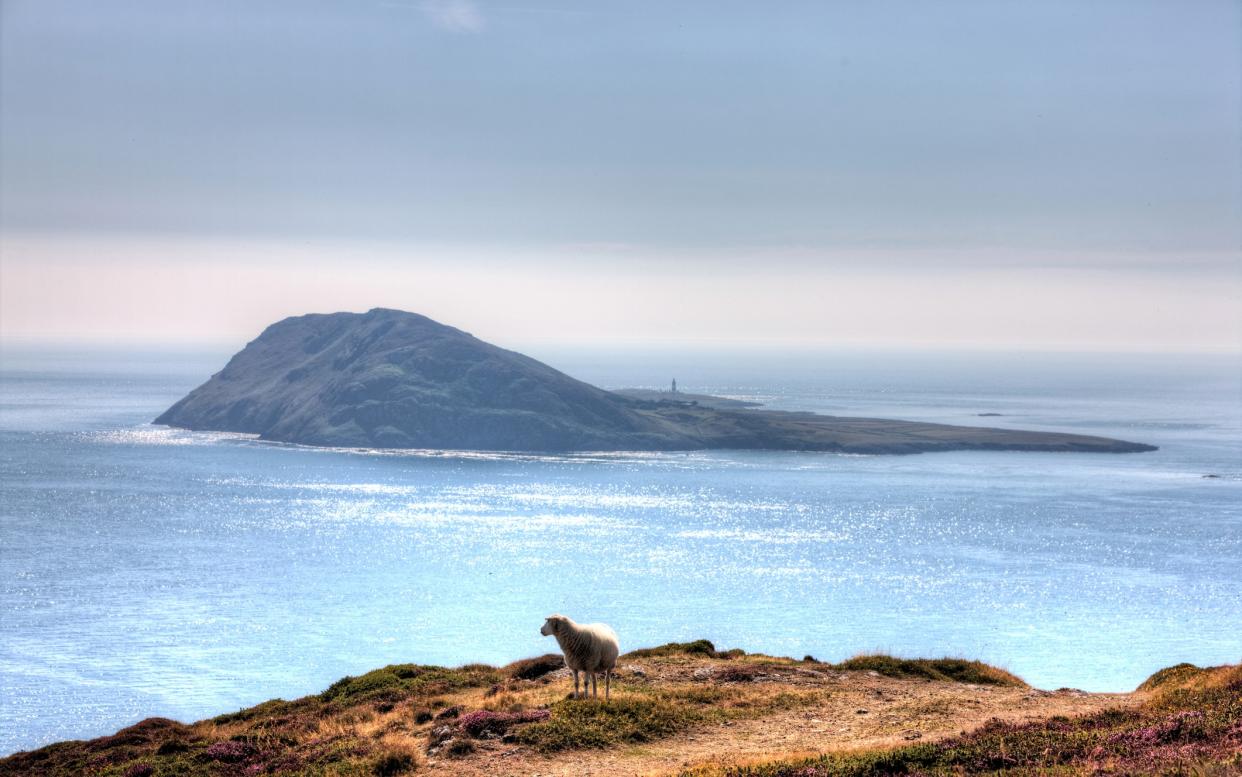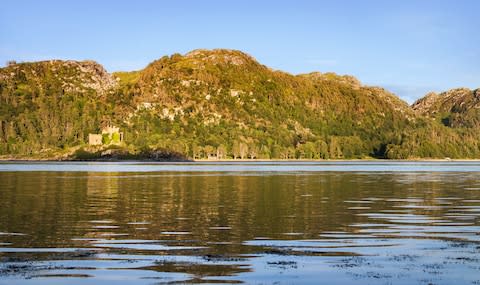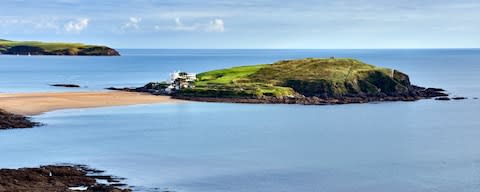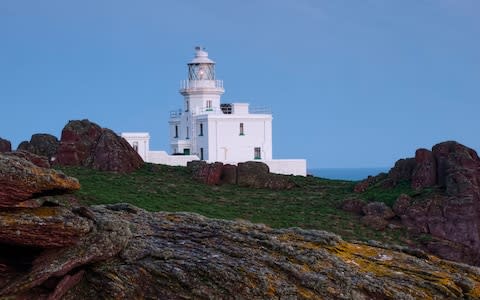Tiny British islands you must discover this summer

There are 67 million people crammed into Great Britain. And yet here's an odd thing: if you want Crusoe-style isolation without the hassle of a long journey, it's available - right on your doorstep. Some of Britain's loveliest and most remote islands are just a short trip offshore, bringing you to tiny sea-girded worlds where humans are outnumbered by rare marine birds, butterflies, seals and otters.
On these rocky outcrops, remote means limited communication, no cars and sometimes no electricity. Some, such as Burgh Island and Piel, are part-time islands, cut off only at high tide. Others combine wilderness with very comfortable digs; or certainly room to pitch a tent. Alternatively, islands such as the Calf of Man provide basic bunks in warden-run accommodation. There is always the risk that you will be stranded on your island - this is weather-beaten Britain, after all - but that's all part of the experience.

Eilean Shona: Peter Pan's playground
"We have mountains and lochs and boats and tennis and billiards and most of the Western Isles of Scotland lying at our feet," wrote JM Barrie about his favourite island retreat. Just over two miles long and a 45-minute yomp cross-island, Eilean Shona rises like a lumpy clump of moss from the calm waters of Loch Moidart off the Ardnamurchan Peninsula. And as the author so aptly described, the vista is of enchantingly tiny uninhabited islands - the stuff of children's stories.
Eilean Shona is a private island, but you can rent a simple cottage, or take over characterful and luxurious Eilean Shona House, where staff will feed you island oysters, prepare delicious meals and make up picnics. This is where Barrie stayed in the 1920s, writing his screenplay for the first film adaptation of Peter Pan. Spend your days walking, canoeing, treasure-hunting, crabbing, fishing or building sandcastles on Shoe Bay. There's also the chance to spot eagles, otters, rare seabirds and seals.
Getting there
Booked guests are ferried over from the mainland.
Staying there
Eilean Shona offers both cottages and hire of Eilean Shona House (eileanshona.com).

Rona: Skye and sea
Abandoned in the 1940s, Rona, a craggy 2,000-acre outpost off Skye, was bought by a Danish ecologist in 1992 who instigated a huge regeneration programme, introducing rare fauna, highland cattle and deer. Save the island's caretaker, who greets visitors with tea and scones and points out the mile-and-a-half track to a handful of beautifully converted bothies, you'll have it to yourself. Spend days scrambling to the summit of Meall Acarseid, Rona's highest point, yomp over to Church Cave - a dramatic rock fissure where islanders used to worship - or simply gaze out of your window in the hope of spotting whales, dolphins, seals and otters.
The weather can be treacherous and you may get cut off. That's when the cottage's lobster creel will be handy.
Getting there
A private ferry for guests runs from Portree in Skye. Journey time is one hour.
Staying there
Visit the isleofrona.com to book a self-catering cottage and transfers.

Burgh Island: Art Deco retreat
Like some dotty Heath Robinson invention, a bizarre-looking sea tractor trundles the short distance from Bigbury-on-Sea, in the South Hams area of Devon, to 26-acre Burgh Island. At low tide you can walk across the sands, but high tide is when this former haunt of pirates, smugglers and monks really comes into its own. The only place to stay happens to be a pricey Art Deco hotel - but glamorous surroundings certainly don't diminish the joy of lying in bed listening to gulls competing with the lashing waves, or the fury of a winter wind whipping against this rocky idyll.
The hotel attracted many famous clients in its heyday, from Agatha Christie to King Edward VIII and Wallis Simpson. Now it's wall-to-wall anniversary couples. Even so, days unfold into glorious solitude as you trace wind-buffeted pathways down to tiny, lagoon-like coves. Visit in the spring and autumn and there's a good chance of spotting pods of dolphin playing in Bigbury Bay.
Getting there
See above.
Staying there
Burgh Island Hotel offers dinner, bed and breakfast.

Bardsey: Seabirds and saints
Resembling a giant hump-backed whale with its mound of Mynydd Enlli towering over a tapering plain of neat lowland fields, tiny sheep-strewn Bardsey is set across from the rugged Lleyn Peninsula. The air pulsates with the cries of countless migratory birds, which stop here to breed, and there are porpoise, dolphin and basking grey seal, rare butterflies, the world's oldest apple tree, and more than 300 different species of lichen.
Bardseyites reckon Arthur and Merlin were buried in the island's cave. A medieval abbey recalls Bardsey's importance as a pilgrim site. Thousands flocked here in the Middle Ages, and many hoped to end their days buried in a place they regarded as the "very porch of heaven". Nowadays, it's day-trippers rather than would-be saints who cross the Sound. But over-crowding is never a problem on this two-mile-long island.
Getting there
You can visit the island for a day with Bardsey Island Boat Trips. Tours take three to four hours.
Staying there
The Bardsey Island Trust has nine self-catering properties, costing from £270 to £695 per week. The ferry costs a further £40 per person.

Piel Island: King of the castle
Our present Queen is not the only reigning British monarch. If you stay on 500-acre Piel Island, off Barrow-in-Furness, the chances are you will bump into its new king - the landlord of Piel's Ship Inn. On this island, a crazy tradition probably originating from the time Lambert Simnel was given safe haven here dictates that whoever runs the pub rules the island. Following the retirement of the last landlord, Rod Scarr, in 2006, an incumbent took over, Steve Chattaway.
If cheery, beer-dispensing royals aren't enough, there's also Piel's colourful smuggling past - dating back to its medieval monks, and tied in to the red-stone "castle", the ruins of which are a distinctive island feature. There's not a lot to do on this flat, teardrop-shaped speck of land except enjoy a few shore walks or observe nesting seabirds, or join a seal watching boat trip. Essentially it's Piel's eccentricity that draws visitors. You can camp, pop along to the Ship Inn, and even request a knighthood. Duties include buying everyone a drink.
Getting there
A ferry crosses from neighbouring Roa Island daily from 11am until 430pm during the summer season.
Staying there
Camping fees are £5 per tent per night and must be prebooked. Call 07516453784 for details.
Calf of Man: Lonely outpost
Far from the ear-splitting roar of the Isle of Man's TT races, remote Calf of Man is a place to feel at one with the elements. Situated half a mile off the turbulent waters of the main island's south-west coast, this 600-acre rocky outcrop operates primarily as a bird observatory and nature reserve. Wardens live here, but if you fancy joining them for a night or two of stargazing and listening to the extraordinary nocturnal chatter of breeding storm petrels and Manx shearwaters, or spending your days watching basking sharks and seals, then Calf is for you.
It also has a huge population of rabbits, which are fast turning Calf into some marine version of Watership Down. Should the heavens open, you won't find any trees to shelter under, for this is primarily a flat expanse of heathland, ancient burial grounds and coastal grassland, with the odd patch of wild flowers to break the monotony. There is very basic accommodation; bear in mind you'll need warm clothes and in bad weather you can easily get stranded.
Getting there
Weather permitting, transfers are from Port St Mary or Port Erin with a journey time of 30-45 minutes.
Staying there
Stays at the Calf of Man Bird Observatory hostel cost from £40. Visitors must bring their own food and supplies.

Skokholm: Puffin paradise
Skokholm, a mile-long nature reserve off the south-west tip of Pembrokeshire, suits those in search of a proper off-grid holiday. Options include three, four, or seven-night stays in an 18th-century farmhouse or a renovated cowshed. Visitors will have the company of razorbills and guillemots, puffins, grey seals and harbour porpoise.
Getting there
A ferry crossing from Martin's Haven costs £27.50 return and is in addition to accommodation costs pre-booked and organised by the Wildlife Trust of South and West Wales.
Staying there
Visit welshwildlife.org for more details.


